Written March 18, 2018
I’ve been
writing my blog now for over 10 years, and it’s been a good vehicle for me to
share my enthusiasm for the great things I see on my tours as well as to share
what’s going on in my life. Often I’ve been surprised by how many people read
my blog whom I’ve never met, even though most of my closest friends and family
(the intended primary audience) aren’t usually among them.
One follower
stood out, someone I eventually realized checked my blog every morning – even
after my not posting anything for several weeks – but this was someone I
actually knew. I first met Jarid Simons in 2002, a full five years before I
even began my blog, when I helped lead field trips at the North American
Butterfly Association meeting in Bend, Oregon. I think he also attended the
joint meeting of Oregon Field Ornithologists, Western Field Ornithologists, and
the Western Bird Banding Association in Ashland in 2004, where I also led field
trips. He, more than anyone else, paid precise attention to everything I wrote
and came to me with comments and questions, and this often led to other
discussions. He never posted comments directly to my blog, but rather we would
have long telephone conversations a few times a year about my travels and other
things.
Jarid died at
the age of 79 last week, rather unexpectedly, and we had actually made a date
to speak by phone later this month, knowing I had a couple weeks off now. We
last spoke in December, and I had no idea he had fallen ill. I dedicate this
particular blog to him, and I know he would have read every last word. Here’s a
photo of a scarf I knitted for him year before last, given to him just over a
year ago. It’s a very simple linen stitch (making a nice, flat fabric, but
taking twice as long to knit as a normal stitch), from alpaca I bought in Peru.
I think he liked it.
Where I last
left off, in late September I had just finished the SE Peru tour that took us to Machu Picchu
then over the mountains and back from Cusco. This second tour, summarized in the photos below, followed immediately afterward and mimics the latter half of my older tour, visiting the lower elevation lodges
based out of Puerto Maldonado, at the junction of the Tambopata and Madre de
Dios Rivers. After a delayed
flight, a slow driver, and an extended transfer of bags in a dusty, windy
mining port, we were on the river headed upstream over an hour and a half later
than predicted. I was determined to not stop for birds, just to get to our
destination before dark, but we had to stop for my first Chopi Blackbirds in
Peru – a small group foraging on the beach of the Madre de Dios River. It seems
they may be invading the country from Bolivia.
Our first
home for several days was the Los Amigos Biological Station, where I have
stayed twice previously. It didn’t look like this when we arrived though – it
was well after dark, as the river was perilously low after an extended drought,
our boat was much slower than expected, and as dusk approached, the captain
went slower and slower, trying to avoid running into trees that weren’t as
submerged as they otherwise should be. A consolation was witnessing well over 100
Sand-colored Nighthawks foraging over the river right at dusk in all directions from our boat. It was magical.
Most
evenings around our cabins we could hear Tawny-bellied Screech-Owl, and with
out much effort we were able to see this one.
In four full
birding days we saw and heard 249 species of birds, despite our having covered
very little of the trail system and having walked very, very slowly at times
due to one of the participants being particularly handicapped (to the
frustration of everyone in the group). The variety of habitats here is quite
astonishing, and nevertheless we had some really memorable sightings. I got few
photos of birds though, two certainly worth sharing. One was this immature
Rufescent Tiger-Heron that foraged at the edge of the main compound clearing,
One might presume that it was pushed out of a nearby oxbow lake when its
parents wanted their territory back to begin a new season of nesting, so it
chose this very aberrant habitat, presumably finding grasshoppers, lizards, and
other critters to eat.
Another
notable photo is of this Southern Scrub-Flycatcher, one of several we had here,
almost daily. I learned the call note of this austral migrant several years ago
at Cristalino Jungle Lodge, but it’s very high pitched, short, and easily
overlooked. And thanks to the difficulty of seeing and identifying seen-only
birds this drab in the high canopy, it’s rarely recorded in the region. I suspect
it’s actually a very common bird, as least during a short time of year.
This
melastome has very distinctively shaped leaves, and it turns out to be identifiable
from them, at least here: Miconia
tomentosa.
One of the
participants noticed these unusual caterpillars on a plant while we were birding
one morning, and I recognized them from having photographed the same thing in
Costa Rica 13 years ago. It’s the limacodid moth Acharia nesea.
Around the
lodge buildings I found it worthwhile to scan the screened windows for moths. I
found two particularly lovely individuals. This is the erebid Eulepidotis consequens.
There’s
actually a good paper on keying out the click beetles in this genus. It is Semiotus ligneus, which I’ve seen in
Costa Rica and at Cristalino Jungle Lodge.
I’ve seen
this Tityus scorpion here before, but
so far getting beyond genus has not been possible. Some members of this genus
are known to have quite painful or even dangerous stings.
I had one
amazing night for mammals, but unfortunately none of the participants had the energy
to join me. I actually went out two nights in a row, to the same area, and each
night was quite different. The first night I went out to do playback for
Silky-tailed Nightjar and Rufous Nightjar in an area of bamboo where we had
flushed a silent bird during the day. There was no response, but I eventually
decided we had seen Silky-tailed Nightjar – not large or rufous enough for the
latter species – and I heard (and recorded) an unusual song from White-throated
Tinamou and had great views of Rufous-banded Owl. So the next night I returned
with two participants to look for the owl, and when it didn’t appear within two
minutes, they decided they had had enough and went back to the rooms. I
continued on and had the owl just 2 minutes later, but they were already out of
earshot.
Then I heard
Night Monkeys and wandered a bit farther down the trail. I glimpsed a mouse
scampering. I heard some mystery sounds coming from the distant canopy. I
wandered farther yet to the bamboo patch and tried trolling the two species of
nightjars again (no success). I heard another distant hoot of a Night Monkey and
continued on. Something moving in the canopy turned out to be an Olingo (an
arboreal member of the raccoon family Procyonidae) and I spent some time
watching two of them and getting sound recordings of the calls. I heard a
Mottled Owl and at least two Tawny-bellied Screech-Owls, saw another mouse, and
then remembered I had to get up early so began what was now about a kilometer
walk back to the cabin. Just as I got to the clearing I heard vague movement in
the leaf litter just left of the trail, and at first look there was nothing
there. Then I took two more steps and there was this South American Tapir, Tapirus terrestris, quietly feeding on
fallen palm fruits just 10 feet away.
Just a few
yards along, almost to the dining hall, was this Brazilian Rabbit, Sylvilagus brasiliensis.
Then
finally, I heard a strange scratching noise at the lab building next to the
dining hall, and my headlamp’s light fell onto this huge Brazilian Porcupine, Coendou bicolor, steadily gnawing away
on the plaster and cement of the outdoor sinks. What a night!
Thanks to my
client-friend Susanne Sourell, whom I guided here a couple years earlier (see
the blog HERE),
I’m paying attention to mushrooms more than I used to. This mushroom-like
oddity actually turns out to be the sporulating stage of Physarella oblonga, a slime-mold, very far removed from mushrooms
and more closely related to amoebas (and therefore animals).
I also know
a little more of what to look for and photograph to help later with species
determinations. This one had a peculiar loose, powdery scaling on top and
thought for sure something so distinctive would be easily named. So far, no one
has come up with anything closer than suggesting the family, Agaricaceae, which
includes well over a thousand species.
I also
thought to give it a whiff, as some mushrooms have a distinctive odor that
helps in the ID. Big mistake. That exfoliate on top is rather airborne and
arrived as a cloud in my nasal passages, but with no immediate effect. After
about 15 minutes though, it felt like I had snorted a 1/4 teaspoon of cayenne
powder, and the burn lasted about four hours. A runny nose and very frequent
sneezing lasted at least another 6 hours, well into the night, but gradually
decreased overnight. No symptoms remained the next morning.
I could go
on and on about how great Los Amigos Biological Station is, but I actually had
time for more photos of things at our next lodge, Explorer’s Inn up the
Tambopata River from Puerto Maldonado. The reasons for doing Explorer’s Inn in
addition to Los Amigos was for the things they had that was lacking at Los Amigos – a big cocha for a boat
ride, a canopy tower, and a riverbank with parrots mining it for salt. But I
was rather disappointed on most accounts. Most aggravating was that I was lied
to about the tower’s improvements – they didn’t build the extra level above the
scientific equipment, so it was useless and we had no access to that most
amazing part of the forest. The parrot cliffs were underwhelming. And while the
boat ride was really good, we actually were able to do one on a smaller,
gorgeous cocha at Los Amigos as well, something I didn’t know was an option when
we arrived. To top it off, they had basically only one good, highly used trail
for us, with several miles of all the secondary trails that reach into
different habitats in atrocious condition. They had done no obvious trail maintenance
in months, and this is the sort of thing that needs at least weekly attention.
Here are some shots of our group having to navigate some tricky tree falls when
I took one of those trails our first morning. I’ve changed my tour’s itinerary,
and later this year we’ll instead be going up the Madre de Dios to a lodge I
know has excellent cochas, canopy platforms, and a parrot cliff (and really
nice rooms and food!).
Don’t get me
wrong though – we saw some amazing things at Explorer’s Inn, as the forest is
just as rich as any in the region, and as my following photos attest. If you
are young, fit, love to scramble and bushwhack, and adjust your expectations
accordingly, you’ll probably not know that there could be any place better. We
had some of the best views of several monkeys here, including the Colombia Red
Howler, Alouatta seniculus.
This
Black-faced Antbird found a close perch to sing from and sat there for several minutes,
allowing me to get slow shutter speed photos of it with my camera on the
tripod.
Given that
there was just one trail, we walked it again and again, so it was quite a
surprise on the last morning to find a pair of vocal Pavonine Quetzals right
over it, just a couple hundred meters from the lodge clearing. They were so
close to the lodge, I was able to go get the one participant who had decided to
stay back this morning, and everyone had great views.
Some of the
best birds we saw were right around the lodge’s clearing, such as Blue-headed
Macaw, and this amazing Gould's Jewelfront, found by a participant who just
couldn’t take an afternoon break. Amazingly, it stayed put long enough for all
of the group to see it.
These Spix's
Guans were active around the clearing off and on, and their interactions with a
Roadside Hawk one evening quite amusing.
We took a
boat ride on the lake called Cocha Tres Chimbadas downriver and opposite the
lodge, where we had great views of Sungrebe, Greater Ani, both American Pygmy
and Green-and-rufous kingfishers, and the rather local in Peru Rusty-margined
Flycatcher. This Hoatzin was one of a few family groups we saw during the quiet
paddle.
Sensing us
as danger, a Black Caiman, Melanosuchus
niger, swam out from the shore where it felt more safe, but keeping an eye
on us also meant being mobbed by many colorful tabanid flies.
On the shore
of the Tambopata River itself was this cooperative Horned Screamer, a distant
relative of geese and ducks.
The banks of
the river were good for butterflies and insects, including this bee in the
family Megachilidae (mason bees and leafcutter bees).
This
photograph of a bee in the genus Centris attracted
the attention of Dr. Felipe Vivallo of the Universidade Federal do Rio de
Janeiro, as he wanted to use it in a paper he is writing about the biology of
this tribe (Centridini).
It had been
unusually cool during the whole tour, which no one complained about, but it
didn’t encourage butterfly activity. Finally, on the last two days it warmed up
into the 90s (°F), and suddenly there were butterflies along the trail, including
several nice hairstreaks. This big one is Evenus
tagyra.
This
relative of the fancy blue morphos that everyone knows is the less frequently
noticed but equally beautiful Antirrhea
philoctetes.
Thanks to
iNaturalist, I found that these leaf-footed bugs feeding communally on the sap
of a small tree are Pachylis pharaonis.
I had first
thought this was one of the rarely seen riodinid butterflies, like the Zelotaea phasma I had seen at Cristalino
Jungle Lodge a few years ago, but upon inspection of my photo, the feathered
antennae show it to be a moth, probably in the family Geometridae, and possibly
Tarma (Perigramma) theodora.
This arctiine
moth is one of the best wasp mimics I’ve seen. I found it on a sprig of
Heliotrope I plucked from the river bank and hung in the forest understory
along the trail. Plants like this in the family Boraginaceae, quite rare in the
forest understory, have the pyrrolizidine alkaloids that are so loved by
arctiine moths and ithomiine butterflies, so this is a good way to find these
elusive insects.
This is a
nymphal stage of one of the tropical lubbers Tropidacris, found on the trail
side one day.
Also along
the trail was this Mionochroma sp.,
perhaps the most colorful genus of longhorn beetles.
This is
another fruiting stage of Physarum
pezizoideum, a slime mold, related to the one we had at Los Amigos.
On the other
hand, here is a real mushroom – Tetrapyrgos
nigripes, known as the little blackfoot.
Finally, I
went out a few times at night, usually on my own or with only one or two other
participants. It’s a different world out there, and if there are no owls
around, you can find some great stuff just looking down. A jumping spider with
unusually long legs, genus Lyssomanes.
A katydid (Tettigoniidae)
doing an excellent job at mimicking a leaf.
A Western
White-lipped Frog, Leptodactylus didymus,
identified mostly based on location.





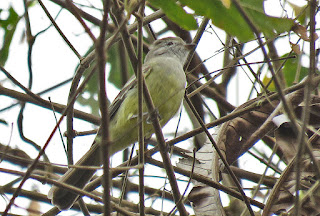















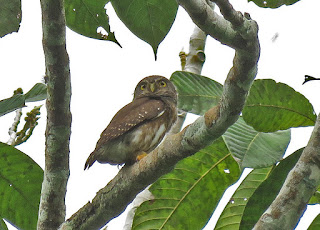




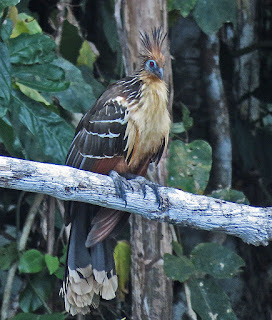


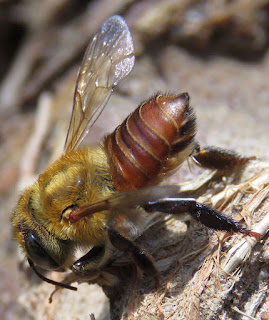

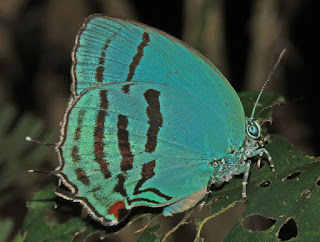
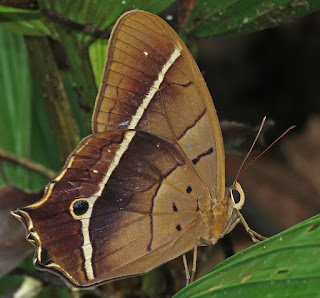







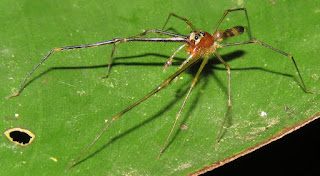
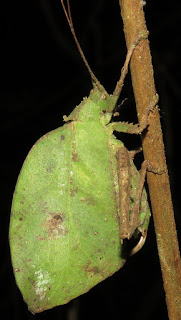










I love the Tambopata region. I saw my first Jaguar there! And my first Hoatzin on one of the oxbow lakes while searching for the Giant Otters. Hope you are well and sorry to hear about your friend. Take care! Chris
ReplyDelete